Multiple Reflections and the Near-Field Effects on a Metamaterial Quarter-Wave Plate
Abstract
:1. Introduction
2. QWP Design and Analysis
3. Near-Field Effects and Cascading Behaviors
4. Discussion
Author Contributions
Funding
Institutional Review Board Statement
Informed Consent Statement
Data Availability Statement
Conflicts of Interest
References
- Zaidi, A.; Rubin, N.A.; Dorrah, A.H.; Park, J.S.; Capasso, F. Generalized polarization transformations with metasurfaces. Opt. Express 2021, 29, 39065–39078. [Google Scholar] [CrossRef] [PubMed]
- Li, A.; Chen, W.; Wei, H.; Lu, G.; Alù, A.; Qiu, C.W.; Chen, L. Riemann-encircling exceptional points for efficient asymmetric polarization-locked devices. Phys. Rev. Lett. 2022, 129, 127401. [Google Scholar] [CrossRef] [PubMed]
- Liang, Y.; Lin, H.; Koshelev, K.; Zhang, F.; Yang, Y.; Wu, J.; Kivshar, Y.; Jia, B. Full-stokes polarization perfect absorption with diatomic metasurfaces. Nano Lett. 2021, 21, 1090–1095. [Google Scholar] [CrossRef] [PubMed]
- Zhao, J.; Li, N.; Cheng, Y. All-dielectric InSb metasurface for broadband and high-efficient thermal tunable terahertz reflective linear-polarization conversion. Opt. Commun. 2023, 536, 129372. [Google Scholar] [CrossRef]
- Li, J.; Hu, G.; Shi, L.; He, N.; Li, D.; Shang, Q.; Zhang, Q.; Fu, H.; Zhou, L.; Xiong, W.; et al. Full-color enhanced second harmonic generation using rainbow trapping in ultrathin hyperbolic metamaterials. Nat. Commun. 2021, 12, 6425. [Google Scholar] [CrossRef] [PubMed]
- Smith, D.R.; Pendry, J.B.; Wiltshire, M.C.K. Metamaterials and Negative Refractive Index. Science 2004, 305, 788–792. [Google Scholar] [CrossRef]
- Pendry, J.B.; Schurig, D.; Smith, D.R. Controlling electromagnetic fields. Science 2006, 312, 1780–1782. [Google Scholar] [CrossRef]
- Pors, A.; Bozhevolnyi, S.I. Efficient and broadband quarter-wave plates by gap-plasmon resonators. Opt. Express 2018, 26, 7287–7296. [Google Scholar] [CrossRef]
- Cheng, B.; Wang, L.; Zou, Y.; Lv, L.; Li, C.; Xu, Y.; Song, G. Large bandwidth and high-efficiency plasmonic quarter-wave plate. Opt. Express 2021, 29, 16939–16949. [Google Scholar] [CrossRef]
- Zhao, Y.; Alù, A. Manipulating light polarization with ultrathin plasmonic metasurfaces. Phys. Rev. B 2011, 84, 205428. [Google Scholar] [CrossRef]
- Chen, H.T.; Taylor, A.J.; Yu, N. A review of metasurfaces: Physics and applications. Rep. Prog. Phys. 2016, 79, 076401. [Google Scholar] [CrossRef] [PubMed]
- Thangarasu, S.; Siva, V.; Kannan, S.; Murugan, A. Highly Efficient Materials for Photonic Crystal-Based Optical Components. In Photonic Crystal and Its Applications for Next Generation Systems; Springer: Berlin/Heidelberg, Germany, 2023; pp. 53–69. [Google Scholar]
- Liu, D.; Lv, T.; Dong, G.; Liu, C.; Liu, Q.; Zhu, Z.; Li, Y.; Guan, C.; Shi, J. Broadband and wide angle quarter-wave plate based on single-layered anisotropic terahertz metasurface. Opt. Commun. 2021, 483, 126629. [Google Scholar] [CrossRef]
- Wang, D.; Gu, Y.; Gong, Y.; Qiu, C.W.; Hong, M. An ultrathin terahertz quarter-wave plate using planar babinet-inverted metasurface. Opt. Express 2015, 23, 11114–11122. [Google Scholar] [CrossRef]
- Weis, P.; Paul, O.; Imhof, C.; Beigang, R.; Rahm, M. Strongly birefringent metamaterials as negative index terahertz wave plates. Appl. Phys. Lett. 2009, 95, 171104. [Google Scholar] [CrossRef]
- Zhang, Z.; Gong, Y.; Pang, K. Optimization and design on multi-layers of dielectric metasurface as broadband terahertz quarter wave plate. J. Opt. 2022, 24, 105101. [Google Scholar] [CrossRef]
- Nouman, M.T.; Hwang, J.H.; Jang, J.H. Ultrathin terahertz quarter-wave plate based on split ring resonator and wire grating hybrid metasurface. Sci. Rep. 2016, 6, 39062. [Google Scholar] [CrossRef] [PubMed]
- Pors, A.; Nielsen, M.G.; Della Valle, G.; Willatzen, M.; Albrektsen, O.; Bozhevolnyi, S.I. Plasmonic metamaterial wave retarders in reflection by orthogonally oriented detuned electrical dipoles. Opt. Lett. 2011, 36, 1626–1628. [Google Scholar] [CrossRef]
- Takeda, S.; Mizuta, T.; Fuwa, M.; Van Loock, P.; Furusawa, A. Deterministic quantum teleportation of photonic quantum bits by a hybrid technique. Nature 2013, 500, 315–318. [Google Scholar] [CrossRef]
- Masada, G.; Miyata, K.; Politi, A.; Hashimoto, T.; O’brien, J.L.; Furusawa, A. Continuous-variable entanglement on a chip. Nat. Photonics 2015, 9, 316–319. [Google Scholar] [CrossRef]
- Qiang, X.; Zhou, X.; Wang, J.; Wilkes, C.M.; Loke, T.; O’Gara, S.; Kling, L.; Marshall, G.D.; Santagati, R.; Ralph, T.C.; et al. Large-scale silicon quantum photonics implementing arbitrary two-qubit processing. Nat. Photonics 2018, 12, 534–539. [Google Scholar] [CrossRef]
- Arrazola, J.M.; Bergholm, V.; Brádler, K.; Bromley, T.R.; Collins, M.J.; Dhand, I.; Fumagalli, A.; Gerrits, T.; Goussev, A.; Helt, L.G.; et al. Quantum circuits with many photons on a programmable nanophotonic chip. Nature 2021, 591, 54–60. [Google Scholar] [CrossRef]
- Cheng, X.; Chang, K.C.; Xie, Z.; Sarihan, M.C.; Lee, Y.S.; Li, Y.; Xu, X.; Vinod, A.K.; Kocaman, S.; Yu, M.; et al. A chip-scale polarization-spatial-momentum quantum SWAP gate in silicon nanophotonics. Nat. Photonics 2023, 17, 656–665. [Google Scholar] [CrossRef]
- Zhang, W.; Cheng, K.; Wu, C.; Wang, Y.; Li, H.; Zhang, X. Implementing quantum search algorithm with metamaterials. Adv. Mater. 2018, 30, 1703986. [Google Scholar] [CrossRef]
- Cheng, K.; Zhang, W.; Wei, Z.; Fan, Y.; Xu, C.; Wu, C.; Zhang, X.; Li, H. Simulate Deutsch-Jozsa algorithm with metamaterials. Opt. Express 2020, 28, 16230–16243. [Google Scholar] [CrossRef]
- Ranjbar, A.; Grbic, A. Broadband, multiband, and multifunctional all-dielectric metasurfaces. Phys. Rev. Appl. 2019, 11, 054066. [Google Scholar] [CrossRef]
- Raeker, B.O.; Grbic, A. Compound metaoptics for amplitude and phase control of wave fronts. Phys. Rev. Lett. 2019, 122, 113901. [Google Scholar] [CrossRef]
- Wu, Z.; Ra’di, Y.; Grbic, A. Tunable metasurfaces: A polarization rotator design. Phys. Rev. X 2019, 9, 011036. [Google Scholar] [CrossRef]
- Raeker, B.O.; Grbic, A. Lossless complex-valued optical-field control with compound metaoptics. Phys. Rev. Appl. 2021, 15, 054039. [Google Scholar] [CrossRef]
- Zhou, Y.; Kravchenko, I.I.; Wang, H.; Nolen, J.R.; Gu, G.; Valentine, J. Multilayer noninteracting dielectric metasurfaces for multiwavelength metaoptics. Nano Lett. 2018, 18, 7529–7537. [Google Scholar] [CrossRef]
- Zhou, Y.; Kravchenko, I.I.; Wang, H.; Zheng, H.; Gu, G.; Valentine, J. Multifunctional metaoptics based on bilayer metasurfaces. Light. Sci. Appl. 2019, 8, 80. [Google Scholar] [CrossRef] [PubMed]
- Zhou, Y.; Zheng, H.; Kravchenko, I.I.; Valentine, J. Flat optics for image differentiation. Nat. Photonics 2020, 14, 316–323. [Google Scholar] [CrossRef]
- Davis, J.E.; Güney, D.O. Effect of loss on linear optical quantum logic gates. J. Opt. Soc. Am. B 2021, 38, C153–C159. [Google Scholar] [CrossRef]
- Zhang, X.; Davis, J.E.; Güney, D.Ö. Ultra-thin metamaterial beam splitters. Appl. Sci. 2019, 10, 53. [Google Scholar] [CrossRef]
- Genevet, P.; Capasso, F.; Aieta, F.; Khorasaninejad, M.; Devlin, R. Recent advances in planar optics: From plasmonic to dielectric metasurfaces. Optica 2017, 4, 139–152. [Google Scholar] [CrossRef]
- Bin-Alam, M.S.; Reshef, O.; Mamchur, Y.; Alam, M.Z.; Carlow, G.; Upham, J.; Sullivan, B.T.; Ménard, J.M.; Huttunen, M.J.; Boyd, R.W.; et al. Ultra-high-Q resonances in plasmonic metasurfaces. Nat. Commun. 2021, 12, 974. [Google Scholar] [CrossRef]
- Zhang, S.; Genov, D.A.; Wang, Y.; Liu, M.; Zhang, X. Plasmon-induced transparency in metamaterials. Phys. Rev. Lett. 2008, 101, 047401. [Google Scholar] [CrossRef]
- Güney, D.Ö.; Koschny, T.; Soukoulis, C.M. Surface plasmon driven electric and magnetic resonators for metamaterials. Phys. Rev. B 2011, 83, 045107. [Google Scholar] [CrossRef]
- Tian, Y.; Ghanekar, A.; Ricci, M.; Hyde, M.; Gregory, O.; Zheng, Y. A review of tunable wavelength selectivity of metamaterials in near-field and far-field radiative thermal transport. Materials 2018, 11, 862. [Google Scholar] [CrossRef]
- Pendry, J. Manipulating the near field with metamaterials. Opt. Photonics News 2004, 15, 32–37. [Google Scholar] [CrossRef]
- Von Cube, F.; Irsen, S.; Diehl, R.; Niegemann, J.; Busch, K.; Linden, S. From isolated metaatoms to photonic metamaterials: Evolution of the plasmonic near-field. Nano Lett. 2013, 13, 703–708. [Google Scholar] [CrossRef]
- Sadatgol, M.; Bihari, N.; Pearce, J.M.; Guney, D.O. Scalable honeycomb top contact to increase the light absorption and reduce the series resistance of thin film solar cells. Opt. Mater. Express 2019, 9, 256–268. [Google Scholar] [CrossRef]
- Adams, W.; Ghoshroy, A.; Guney, D.O. Plasmonic superlens imaging enhanced by incoherent active convolved illumination. ACS Photonics 2018, 5, 1294–1302. [Google Scholar] [CrossRef]
- Ou, K.; Yu, F.; Li, G.; Wang, W.; Miroshnichenko, A.E.; Huang, L.; Wang, P.; Li, T.; Li, Z.; Chen, X.; et al. Mid-infrared polarization-controlled broadband achromatic metadevice. Sci. Adv. 2020, 6, eabc0711. [Google Scholar] [CrossRef] [PubMed]
- Chen, M.K.; Chu, C.H.; Lin, R.J.; Chen, J.W.; Huang, Y.T.; Huang, T.T.; Kuo, H.Y.; Tsai, D.P. Optical meta-devices: Advances and applications. Jpn. J. Appl. Phys. 2019, 58, SK0801. [Google Scholar] [CrossRef]
- Xiao, S.; Wang, T.; Liu, T.; Zhou, C.; Jiang, X.; Zhang, J. Active metamaterials and metadevices: A review. J. Phys. Appl. Phys. 2020, 53, 503002. [Google Scholar] [CrossRef]
- Zheludev, N.I.; Kivshar, Y.S. From metamaterials to metadevices. Nat. Mater. 2012, 11, 917–924. [Google Scholar] [CrossRef]
- Chen, F. Near-Field Coupling and Homogenization in All-Dielectric Metamaterials and Their Effects on Applications; Michigan Technological University: Houghton, MI, USA, 2014. [Google Scholar]
- Palmieri, A.; Dorrah, A.H.; Yang, J.; Oh, J.; Dainese, P.; Capasso, F. Do bilayer metasurfaces behave as a stack of decoupled single-layer metasurfaces? arXiv 2023, arXiv:2309.14960. [Google Scholar]
- Saleh, B.E.; Teich, M.C. Fundamentals of Photonics; John Wiley & Sons: Hoboken, NJ, USA, 2019. [Google Scholar]
- Chen, H.T. Interference theory of metamaterial perfect absorbers. Opt. Express 2012, 20, 7165–7172. [Google Scholar] [CrossRef]
- Aslam, M.I.; Güney, D.Ö. On negative index metamaterial spacers and their unusual optical properties. Prog. Electromagn. Res. B 2013, 47, 203. [Google Scholar] [CrossRef]
- Zhang, X.; Adams, W.; Güney, D.Ö. Analytical description of inverse filter emulating the plasmon injection loss compensation scheme and implementation for ultrahigh-resolution hyperlens. JOSA B 2017, 34, 1310–1318. [Google Scholar] [CrossRef]
- Gehr, R.J.; Boyd, R.W. Optical properties of nanostructured optical materials. Chem. Mater. 1996, 8, 1807–1819. [Google Scholar] [CrossRef]
- Siefke, T.; Kroker, S.; Pfeiffer, K.; Puffky, O.; Dietrich, K.; Franta, D.; Ohlídal, I.; Szeghalmi, A.; Kley, E.B.; Tünnermann, A. Materials pushing the application limits of wire grid polarizers further into the deep ultraviolet spectral range. Adv. Opt. Mater. 2016, 4, 1780–1786. [Google Scholar] [CrossRef]
- Siefke, T.; Kley, E.B.; Tünnermann, A.; Kroker, S. Design and fabrication of titanium dioxide wire grid polarizer for the far ultraviolet spectral range. In Proceedings of the Nanoengineering: Fabrication, Properties, Optics, and Devices XIII; SPIE: Bellingham, WA, USA, 2016; Volume 9927, pp. 22–27. [Google Scholar]
- Pang, Y.; Gordon, R. Metal nano-grid reflective wave plate. Opt. Express 2009, 17, 2871–2879. [Google Scholar] [CrossRef] [PubMed]
- Lalanne, P.; Lemercier-Lalanne, D. On the effective medium theory of subwavelength periodic structures. J. Mod. Opt. 1996, 43, 2063–2085. [Google Scholar] [CrossRef]
- Uriri, S.A.; Tashima, T.; Zhang, X.; Asano, M.; Bechu, M.; Güney, D.O.; Yamamoto, T.; Özdemir, S.K.; Wegener, M.; Tame, M.S. Active control of a plasmonic metamaterial for quantum state engineering. Phys. Rev. A 2018, 97, 053810. [Google Scholar] [CrossRef]
- Wang, D.; Liu, W.; Xiao, Q.; Shi, J. Embedded metal-wire nanograting and its application in an optical polarization beam splitter/combiner. Appl. Opt. 2008, 47, 312–316. [Google Scholar] [CrossRef]
- Alasaarela, T. Atomic Layer Deposited Titanium Dioxide in Optical Waveguiding Applications; Aalto University: Espoo, Finland, 2011. [Google Scholar]
- Sarkar, S.; Gupta, V.; Tsuda, T.; Gour, J.; Singh, A.; Aftenieva, O.; Steiner, A.M.; Hoffmann, M.; Kumar, S.; Fery, A.; et al. Plasmonic charge transfers in large-scale metallic and colloidal photonic crystal slabs. Adv. Funct. Mater. 2021, 31, 2011099. [Google Scholar] [CrossRef]
- Zabelin, D.; Zabelina, A.; Miliutina, E.; Trelin, A.; Elashnikov, R.; Nazarov, D.; Maximov, M.; Kalachyova, Y.; Sajdl, P.; Lancok, J.; et al. Design of hybrid Au grating/TiO2 structure for NIR enhanced photo-electrochemical water splitting. Chem. Eng. J. 2022, 443, 136440. [Google Scholar] [CrossRef]
- Grandi, S.; Nielsen, M.P.; Cambiasso, J.; Boissier, S.; Major, K.D.; Reardon, C.; Krauss, T.F.; Oulton, R.F.; Hinds, E.; Clark, A.S. Hybrid plasmonic waveguide coupling of photons from a single molecule. APL Photonics 2019, 4, 086101. [Google Scholar] [CrossRef]
- Rakić, A.D.; Djurišić, A.B.; Elazar, J.M.; Majewski, M.L. Optical properties of metallic films for vertical-cavity optoelectronic devices. Appl. Opt. 1998, 37, 5271–5283. [Google Scholar] [CrossRef]
- Rodríguez-de Marcos, L.V.; Larruquert, J.I.; Méndez, J.A.; Aznárez, J.A. Self-consistent optical constants of SiO2 and Ta2O5 films. Opt. Mater. Express 2016, 6, 3622–3637. [Google Scholar] [CrossRef]
- Ma, X.; Zhao, H.; Zeng, Y.; Gao, S.; Cheng, J.; He, Q.; Mao, J.; Zhou, C.; Xin, G.; Rao, Z. Stokes parameters measurement system designed by symmetric division of amplitude with double quarter-wave plate. Opt. Commun. 2023, 549, 129888. [Google Scholar] [CrossRef]
- Collett, E. Field Guide to Polarization; SPIE: Bellingham, WA, USA, 2005. [Google Scholar]
- Cong, L.; Xu, N.; Gu, J.; Singh, R.; Han, J.; Zhang, W. Highly flexible broadband terahertz metamaterial quarter-wave plate. Laser Photonics Rev. 2014, 8, 626–632. [Google Scholar] [CrossRef]
- Zhao, J.X.; Song, J.L.; Zhou, Y.; Liu, Y.C.; Zhou, J.H. Switching between the functions of half-wave plate and quarter-wave plate simply by using a vanadium dioxide film in a terahertz metamaterial. Chin. Phys. Lett. 2020, 37, 064204. [Google Scholar] [CrossRef]
- Luo, J.; Shi, X.; Luo, X.; Hu, F.; Li, G. Broadband switchable terahertz half-/quarter-wave plate based on metal-VO2 metamaterials. Opt. Express 2020, 28, 30861–30870. [Google Scholar] [CrossRef]
- Güney, D.Ö.; Koschny, T.; Soukoulis, C.M. Reducing ohmic losses in metamaterials by geometric tailoring. Phys. Rev. B 2009, 80, 125129. [Google Scholar] [CrossRef]
- Adams, W.; Sadatgol, M.; Güney, D.Ö. Review of near-field optics and superlenses for sub-diffraction-limited nano-imaging. AIP Adv. 2016, 6, 100701. [Google Scholar] [CrossRef]
- Goudail, F.; Bénière, A. Estimation precision of the degree of linear polarization and of the angle of polarization in the presence of different sources of noise. Appl. Opt. 2010, 49, 683–693. [Google Scholar] [CrossRef]
- Chen, D.; Zeng, H.; Qi, Y.; Liu, H.; Xue, Q.; Sun, X. Single-layer all-dielectric quarter-wave plate and half-wave plate metasurfaces for polarization conversion in the visible light region. Opt. Eng. 2022, 61, 025104. [Google Scholar] [CrossRef]
- Luo, X.; Hu, F.; Li, G. Broadband switchable terahertz half-/quarter-wave plate based on VO2-metal hybrid metasurface with over/underdamped transition. J. Phys. Appl. Phys. 2021, 54, 505111. [Google Scholar] [CrossRef]
- Wang, D.C.; Sun, S.; Feng, Z.; Tan, W.; Qiu, C.W. Multipolar-interference-assisted terahertz waveplates via all-dielectric metamaterials. Appl. Phys. Lett. 2018, 113, 201103. [Google Scholar] [CrossRef]
- Zi, J.; Xu, Q.; Wang, Q.; Tian, C.; Li, Y.; Zhang, X.; Han, J.; Zhang, W. Antireflection-assisted all-dielectric terahertz metamaterial polarization converter. Appl. Phys. Lett. 2018, 113, 101104. [Google Scholar] [CrossRef]
- Ding, F.; Wang, Z.; He, S.; Shalaev, V.M.; Kildishev, A.V. Broadband high-efficiency half-wave plate: A supercell-based plasmonic metasurface approach. ACS Nano 2015, 9, 4111–4119. [Google Scholar] [CrossRef]
- Sadatgol, M.; Özdemir, Ş.K.; Yang, L.; Güney, D.Ö. Plasmon injection to compensate and control losses in negative index metamaterials. Phys. Rev. Lett. 2015, 115, 035502. [Google Scholar] [CrossRef] [PubMed]
- Ghoshroy, A.; Özdemir, Ş.K.; Güney, D.Ö. Loss compensation in metamaterials and plasmonics with virtual gain. Opt. Mater. Express 2020, 10, 1862–1880. [Google Scholar] [CrossRef]
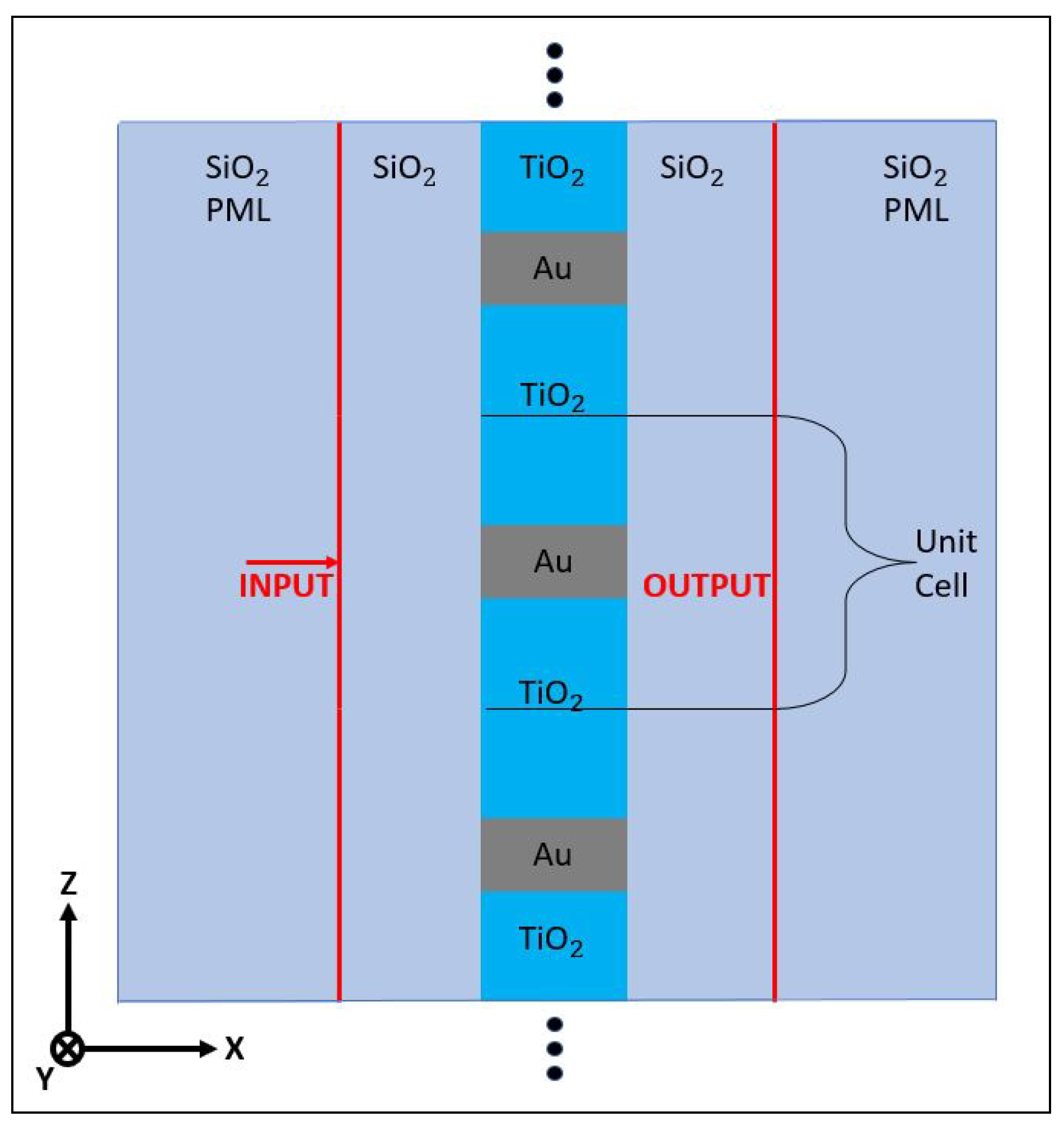
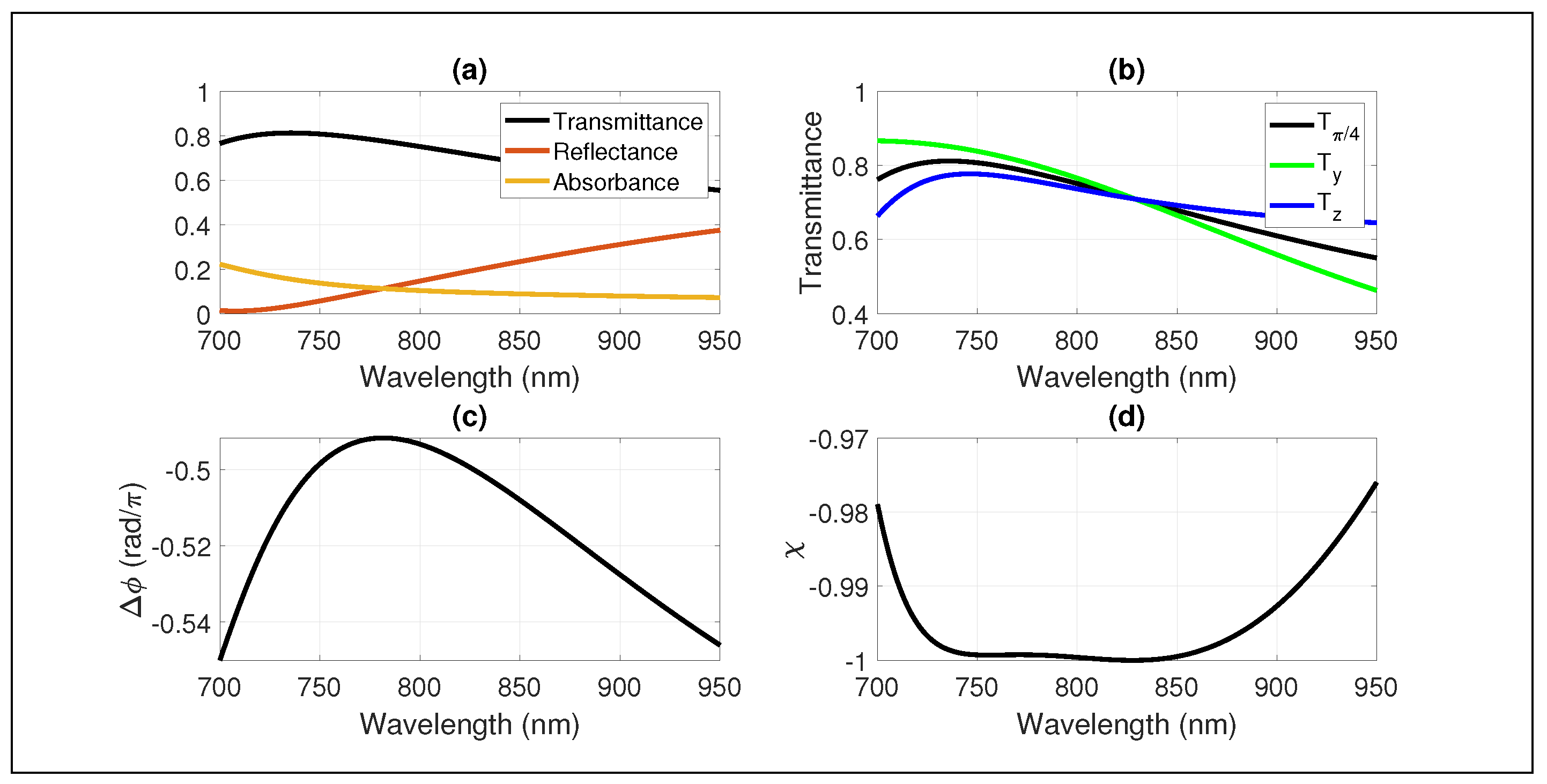

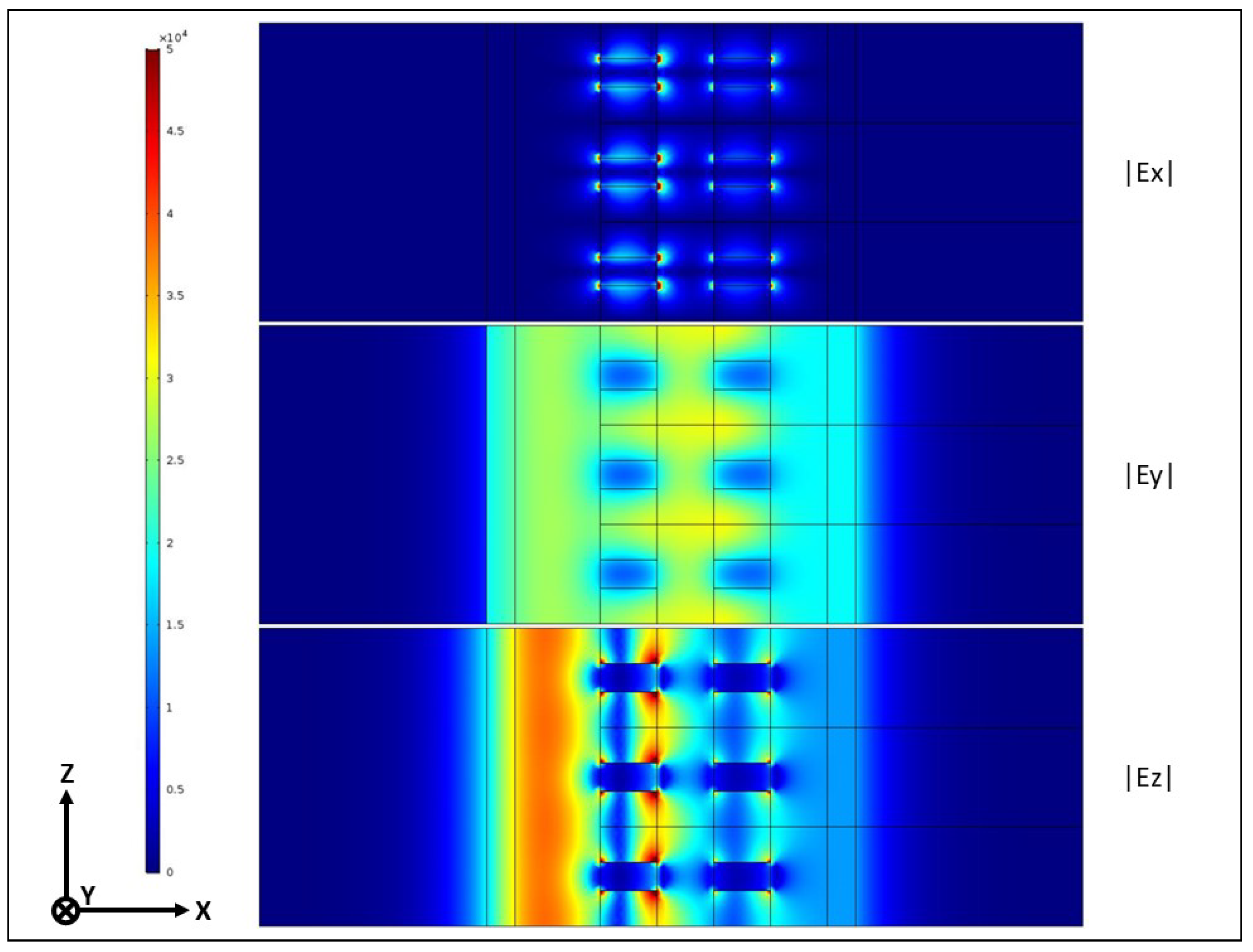
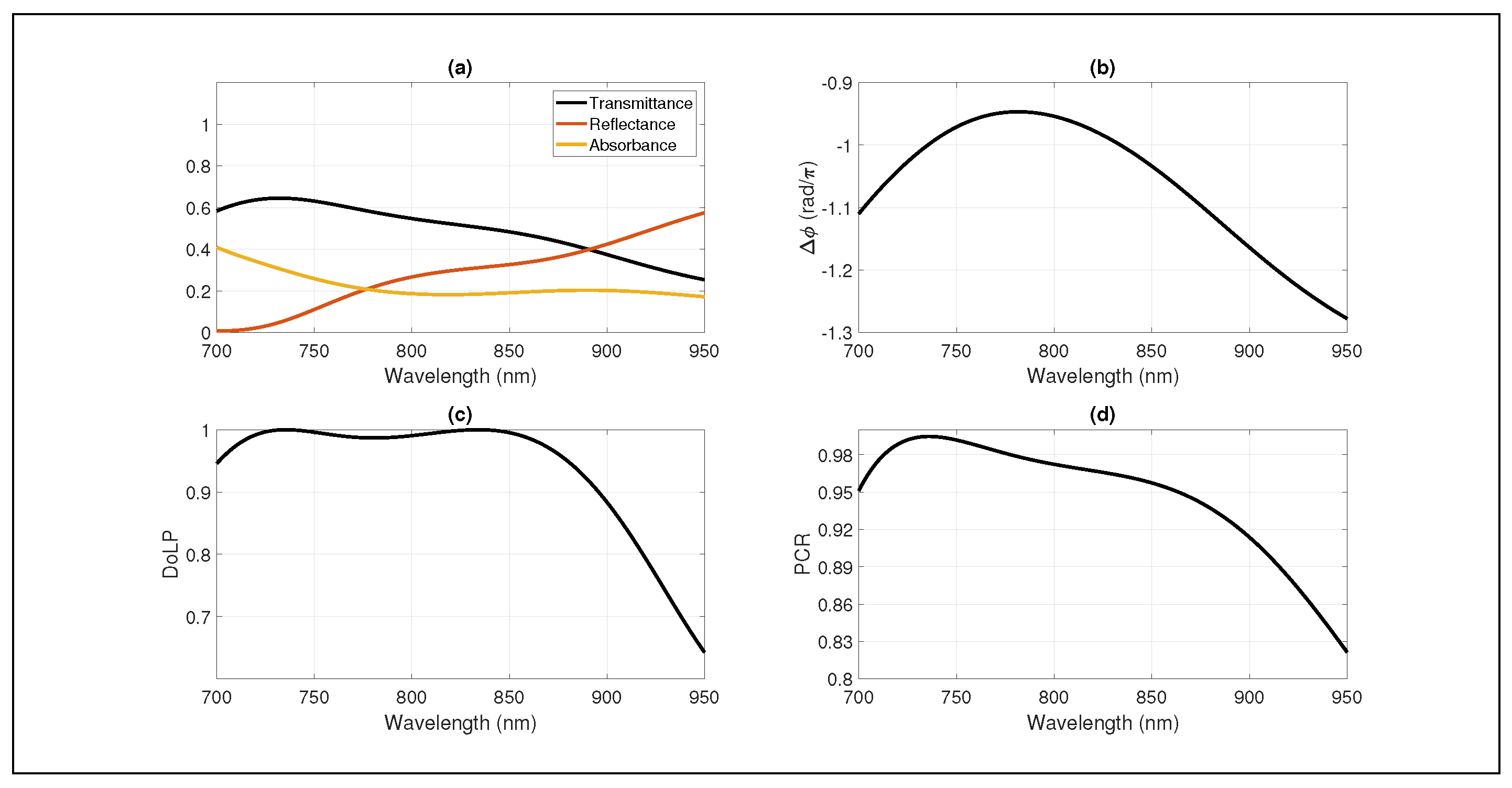
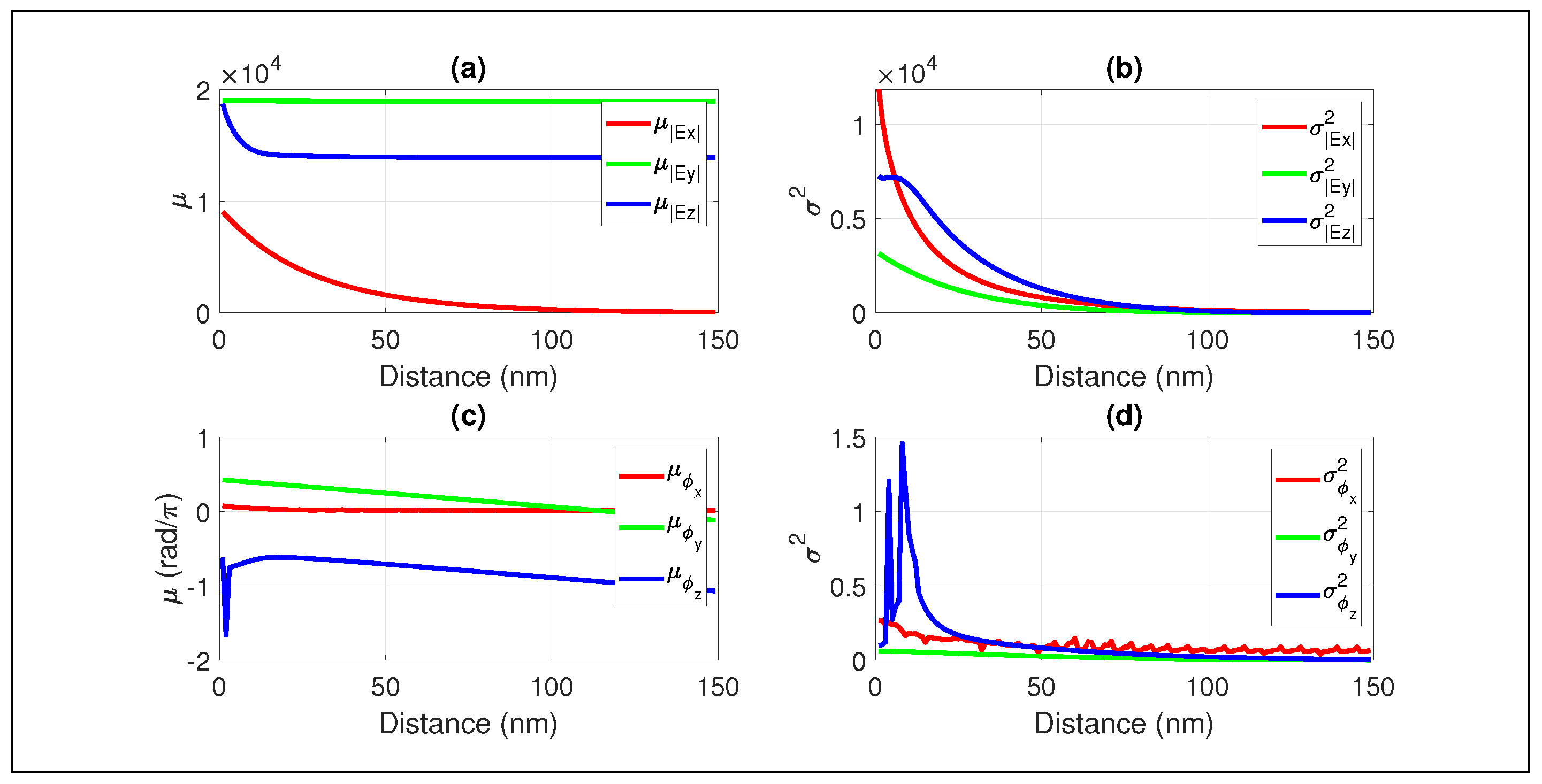
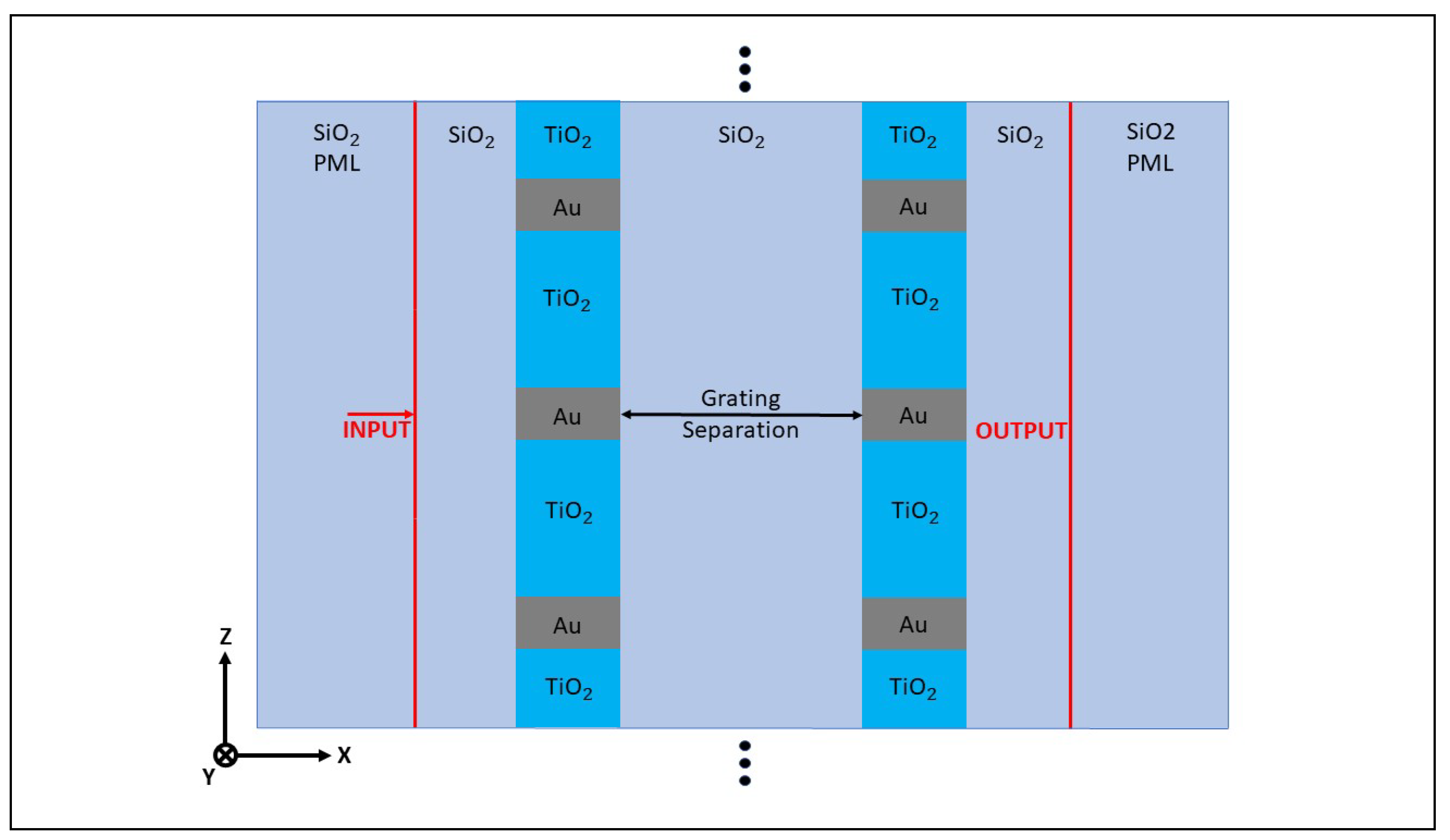

| 700 nm | 800 nm | 950 nm | |
|---|---|---|---|
| SiO [66] | |||
| TiO [56] | |||
| Au [65] |
Disclaimer/Publisher’s Note: The statements, opinions and data contained in all publications are solely those of the individual author(s) and contributor(s) and not of MDPI and/or the editor(s). MDPI and/or the editor(s) disclaim responsibility for any injury to people or property resulting from any ideas, methods, instructions or products referred to in the content. |
© 2023 by the authors. Licensee MDPI, Basel, Switzerland. This article is an open access article distributed under the terms and conditions of the Creative Commons Attribution (CC BY) license (https://creativecommons.org/licenses/by/4.0/).
Share and Cite
Davis, J.; Güney, D. Multiple Reflections and the Near-Field Effects on a Metamaterial Quarter-Wave Plate. Appl. Sci. 2023, 13, 11705. https://doi.org/10.3390/app132111705
Davis J, Güney D. Multiple Reflections and the Near-Field Effects on a Metamaterial Quarter-Wave Plate. Applied Sciences. 2023; 13(21):11705. https://doi.org/10.3390/app132111705
Chicago/Turabian StyleDavis, James, and Durdu Güney. 2023. "Multiple Reflections and the Near-Field Effects on a Metamaterial Quarter-Wave Plate" Applied Sciences 13, no. 21: 11705. https://doi.org/10.3390/app132111705
APA StyleDavis, J., & Güney, D. (2023). Multiple Reflections and the Near-Field Effects on a Metamaterial Quarter-Wave Plate. Applied Sciences, 13(21), 11705. https://doi.org/10.3390/app132111705







